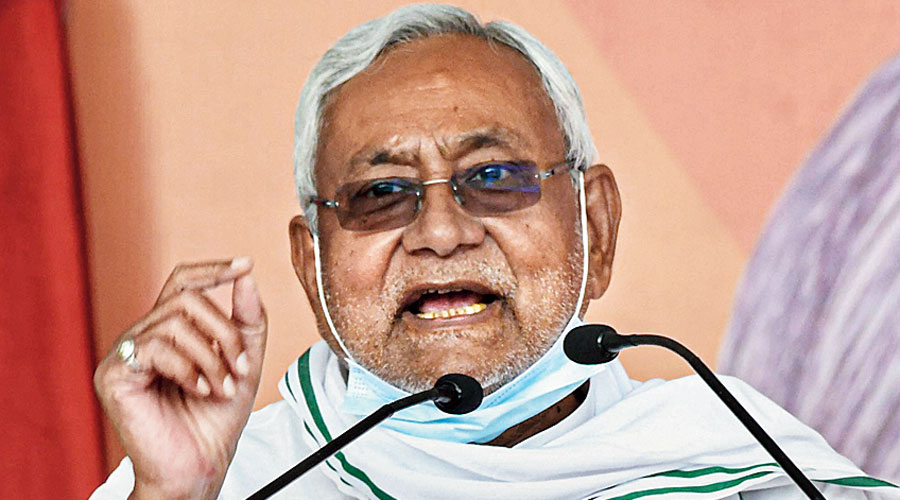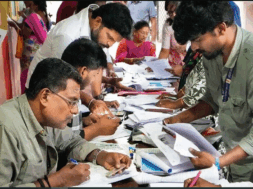
Nitish Kumar May Stick to his Offer to Quit in Favour of BJP, Crucial NDA Meet on Sunday
Manas Dasgupta
NEW DELHI, Nov 13: Even though Nitish Kumar taking over as the chief minister of Bihar for the fourth consecutive term is considered to be a foregone conclusion, a de-spirited JD(U) leader is learnt to be reluctant to continue in view of his party’s poor showing in the just-concluded Assembly elections.
Kumar told media persons in Patna on Friday that all partners of the NDA would meet on Sunday to formally elect the leader. Kumar was learnt to have offered to step down in favour of the BJP at an informal meeting of the NDA leaders held at his residence on Thursday, but the BJP leaders persuaded him not to take any drastic step at this stage. Sources said Nitish was “very upset” at the manner in which Chirag Paswan and his Lok Janshakti Party hurt the JD(U). A senior BJP leader said: “He was deeply disturbed and very upset that Chirag had spoiled JD(U)’s chances in at least 25-30 seats. We persuaded him to remain the CM even though BJP is now a senior partner in the alliance.”
Kumar has also taken to heart the RJD leader Tejaswi Yadav’s advice that he should abdicate the chief ministership after his party was reduced to third spot with only 43 seats as against 74 by the BJP and 75 by the RJD. Sources close to JD(U) said at the formal meeting of the NDA, Kumar would again offer to quit and invite the BJP to take over the leadership for the new term of the NDA.
Kumar so far has neither staked claim for the formation of the new government nor has submitted his resignation as the sitting chief minister to the governor. Both the processes were expected to be followed only after the formal election of the NDA leader at Sunday’s meeting. Though the BJP has emerged the senior partner, it was honouring the commitment given by the prime minister Narendra Modi before the elections that Kumar would stay the NDA leader if it retain majority in the new House. There was no condition attached on the number of seats the partners might get in the elections to decide the leader. Even at the BJP victory celebrations, Modi reiterated the party’s decision to function under Kumar’s leadership.
Agency reports, however, said Sunday’s meeting would be only a formality and Kumar was almost certain to be declared the leader and take oath of the office sometime next week, may be on the auspicious “Bhaiyya Dooj” on Monday or Tuesday. The meeting was also likely to finalise other modalities of the government formation including the sharing of berths in the cabinet between the four partners and other crucial issues. The BJP was likely to reiterate its earlier commitment that Kumar would continue to enjoy similar amount of freedom in deciding the NDA affairs as he did not so far when the JD(U) was the senior partner of the NDA.
The analysis of the election data bring out the change in vote shares of the JD(U) and BJP as compared to the 2019 Lok Sabha elections. The vote shares of both parties dropped in this Assembly election, more so for the JD(U). However, this does not necessarily mean that the BJP performed worse than it did in 2019, the difference is likely because voters are voting differently in national and state elections, a phenomena found common everywhere in the recent past.
The RJD’s vote share dropped slightly as compared to the 2015 Assembly election results when the party was in alliance with Nitish Kumar’s JD(U) whose support base probably provided additional votes to the RJD. And it is perhaps these ‘swing votes’ (who stayed on Nitish’s side when he switched sides) that deprived the RJD of some more seats that could have changed the election results.
A predominant factor in the current election was the variation in the performance of parties within their respective alliances. In RJD-led “Mahagathbandhan,” the Congress clearly pulled the tally down, it has the lowest strike rate (seats won out of contested) and lowest vote share in seats contested in the alliance. Some of it could be because Congress got a higher proportion of seats in NDA strongholds; yet, this was an insufficient explanation and it was beyond any doubt that Congress did worse than other partners in the alliance.
The Congress equivalent on the NDA side seemed to be Nitish Kumar’s JD(U). It won much fewer seats than the BJP and its vote share was also considerably lower than that of the BJP. While there was no denying that the JD(U) did significantly worse than the BJP, the gap between the BJP and the JD(U)’s performance could have been significantly lower in the absence of the damage done by the LJP (NDA ally at Centre, but fielded candidates against JD(U)) by eating into the JD(U)’s vote share. In more than two dozen seats that the JD(U) lost, the margin of victory was lower than the LJP’s vote share.
AIMIM and Left Parties performed better than expected. The left parties won 16 out of 29 seats they contested as a part of the Mahagathbandhan. Asaduddin Owaisi’s AIMIM, which contested in alliance with the Upendra Kushwaha-led RLSP, the BSP and three other parties, won five seats. AIMIM’s vote share has dropped in comparison to 2019, but this is because the party had contested on only one seat in 2019 whereas it contested on 20 seats this time, covering a larger area. Jitan Ram Manjhi’s HAM also managed to improve its performance this time, winning four seats.
The number of female candidates had been abysmally low in Bihar, just like other states. Only 84 women were given ticket by main parties (including Left and LJP), out of which 26 won in an Assembly of 243. On average, female candidates seem to be getting a slightly lesser share of votes than their male counterparts. Again, it could be that parties are giving ticket to female candidates systematically in weaker seats, or, the voters discriminate against female candidates, or, both.
Party-wise break-up reveals that female candidates actually performed better in Congress in this election. The difference was highest in BJP followed by JD(U), and very less in RJD. The trend of lesser vote share for women candidates, however, was not the same for all parties. Despite all the rhetoric of women empowerment in their campaigns, the parties seem to be doing a poor job of giving them actual representation.













